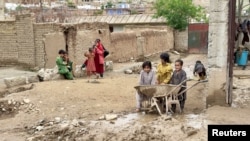The United Nations said Monday that flash floods in Afghanistan, caused by extreme weather events related to climate change, are impacting tens of thousands of children, especially in northern and western provinces.
The impoverished South Asian country has experienced unusually heavy seasonal rainfall and flash flooding over the past month, affecting more than 100,000 people and resulting in loss and damage to houses, infrastructure, and the livelihoods of people in 32 out of 34 Afghan provinces.
The calamity has killed at least 350 people, including women and children, damaging close to 8,000 homes and displacing more than 5,000 families besides destroying crops and agricultural land, according to the U.N. Children’s Fund, or UNICEF.
“The recent extreme weather in Afghanistan has all the hallmarks of the intensifying climate crisis — some of the affected areas experienced drought last year,” the agency noted in a Monday statement.
It attributed the loss of lives and livelihoods and damage to infrastructure to an increase in the “frequency and ferocity” of extreme weather events in the country.
Aid agencies have cautioned that many flood survivors cannot make a living and have been left with no homes, no land, and no source of livelihood.
Tajudeen Oyewale, the UNICEF representative in Afghanistan, urged the international community to redouble efforts and investments to support communities to alleviate and adapt to the impact of climate change on children.
“The growing number and severity of extreme weather events will require UNICEF and other humanitarian actors to step in with even more rapid and large-scale humanitarian responses,” Oyewale added.
He stressed the need for UNICEF and the humanitarian community to prepare themselves for “a new reality of climate-related disasters in Afghanistan.
The war-ravaged country ranks 15th out of 163 countries in the Children’s Climate Risk Index. “This means that not only are climate and environmental shocks and stresses prominent in the country, but children are particularly vulnerable to their effects compared with elsewhere in the world,” UNICEF said.
The Save the Children charity has warned through a recent statement that about 6.5 million Afghan children are forecast to experience crisis-level hunger this year, citing the impact of floods, prolonged drought, and the return of hundreds of thousands of undocumented Afghans from neighboring Pakistan.
The World Food Program estimates that 3 million Afghan children are malnourished, and it can only reach one-third of them. The decline in international assistance has led to a rise in children’s admissions to malnutrition clinics in Afghanistan, the agency cautioned.
Afghanistan, one of the countries most at risk of global climate crisis, is among the least responsible for carbon emissions.
Afghan children are particularly vulnerable to the effects of climate and environmental shocks and stresses compared to elsewhere in the world, the statement said.
The return of the fundamentalist Taliban to power in Kabul in 2021 has led to the immediate termination of financial aid to the country, while international humanitarian assistance has recently also declined. This has worsened humanitarian conditions and pushed Afghanistan’s economy to the brink.








